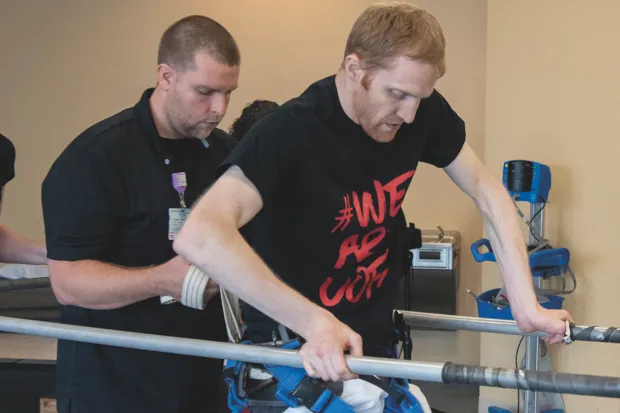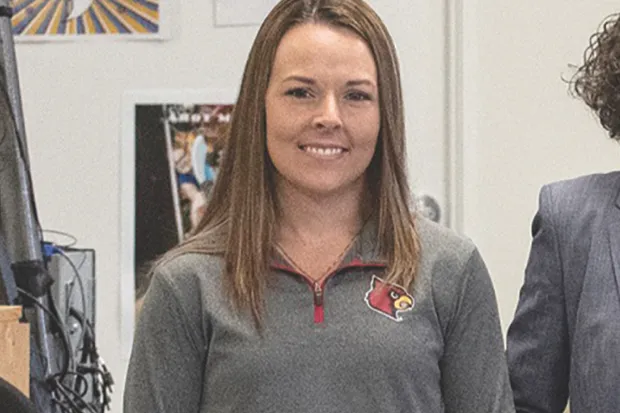Four patients with severe spinal cord injuries can walk again thanks to a new technique that combines electrically stimulating implants and physical therapy, which has been developed by researchers at the University of Louisville.
Of the four patients in the study, all were able to stand independently and two were able to walk with the assistance of walking aids such as walker frames or horizontal balance poles despite being injured more than two years ago.
“This research demonstrates that some brain-to-spine connectivity may be restored years after a spinal cord injury as these participants living with complete motor paralysis were able to walk, stand, regain trunk mobility and recover a number of motor functions without physical assistance when using the epidural stimulator and maintaining focus to take steps,” said Prof Susan Harkema, associate director of the Kentucky Spinal Cord Injury Research Center. “We must expand this research – hopefully, with improved stimulator technology – to more participants to realise the full potential of the progress we’re seeing in the lab, as the potential this provides for the 1.2 million people living with paralysis from a spinal cord injury is tremendous.”
The treatment is based on the idea that, in spite of the damage to the spinal cord, some nerve connections that cross the injury site remain intact. Implants placed below the injury site send pulses of electricity through the area exciting the nerves in the spinal cord. It’s thought that this kickstarts the system: the activity gives the spinal cord, which has been isolated from the brain by the injury, the sensitivity it needs to hear signals from the brain again. This gives the legs a chance to reconnect with the brain and slowly relearn the distinct nerve activation patterns that result in walking via the locomotor training. In a session, the participants are placed into a harness while specially trained staff move their legs to simulate walking on a treadmill.
That’s the theory, in practice however, the precise healing process isn’t fully understood. “Now I think the real challenge starts, and that’s understanding how this happened, why it happened and which patients will respond,” says Kristin Zhao co-principal investigator the study.
Initially, they were unable to stand, walk or voluntarily move their legs, even after eight to nine weeks of daily locomotor training. However, once the stimulators were implanted and switched on, all of the participants were able to stand and two of them were able to walk using mobility aids.
“We are seeing increasing interest in the use of technologies such as epidural stimulation in the treatment of spinal cord injury and restoration of locomotor, cardiovascular and urodynamic functions [bladder control],” said Maxwell Boakye, clinical director of the Kentucky Spinal Cord Injury Research Center. “Epidural stimulation is likely to become a standard treatment with several improvements in design of the device to target more specific neurological circuits.”
Case studies

Following a nasty crash while out riding his mountain bike with a roommate in Montana in 2011, Jeff was left paralysed from the chest down as a result of a broken neck. Following treatment with an epidural stimulator and months of intensive rehab he became the first participant in this study to attain bilateral steps.
“The first steps after my mountain biking accident were such a surprise, and I am thrilled to have progressed by continuing to take more steps each day,” he said. “In addition, my endurance has improved, as I’ve regained strength and the independence to do things I used to take for granted, like cooking and cleaning. My main priority is to be a participant in this research and further the findings, as what the University of Louisville team does each day is instrumental for the millions of individuals living with paralysis from a spinal cord injury.”

As a teenager Kelly loved the outdoors and could often be found riding horses, playing soccer or working on the family farm. But in July 2014 a car accident left her paralysed from the waist down and confined to a wheelchair, with doctors saying she would never be able to walk again. Now, following months of epidural stimulation treatment and strenuous rehab, she has proved the doctors wrong by becoming one of the first paraplegics in the world to take steps under her own power.
“Being a participant in this study truly changed my life, as it has provided me with a hope that I didn’t think was possible after my car accident. The first day I took steps on my own was an emotional milestone in my recovery that I’ll never forget, as one minute I was walking with the trainer’s assistance and, while they stopped, I continued walking on my own. It’s amazing what the human body can accomplish with help from research and technology,” she said. “They were helping me as usual and then they stopped and I took maybe three or four steps in sequence. I just stopped and my lips started quivering, my face got hot and my eyes got teary, and I was like, ‘Oh my God! I just took steps’.”
This is an extract from issue 328 of BBC Focus magazine.
Subscribe and get the full article delivered to your door, or download the BBC Focus app to read it on your smartphone or tablet. Find out more
Follow Science Focus onTwitter,Facebook, Instagramand Flipboard